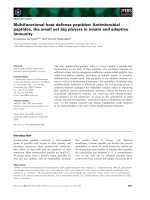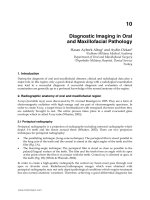Diagnostic Imaging in Oral and Maxillofacial Pathology docx
Bạn đang xem bản rút gọn của tài liệu. Xem và tải ngay bản đầy đủ của tài liệu tại đây (1.83 MB, 25 trang )
10
Diagnostic Imaging in Oral
and Maxillofacial Pathology
Hasan Ayberk Altug
1
and Aydin Ozkan
2
1
Gulhane Military Medical Academy
Department of Oral and Maxillofacial Surgery
2
Diyarbakir Military Hospital, Dental Service
Turkey
1. Introduction
During the diagnosis of oral and maxillofacial diseases, clinical and radiological data play a
major role. In this region, only a good clinical diagnosis along with a radiological examination
may lead to a successful diagnosis. A successful diagnosis and evaluation of clinical
examination are generally up to a profound knowledge of the normal anatomy of the region.
2. Radiographic anatomy of oral and maxillofacial region
X-rays (invisible rays) were discovered by W. Conrad Roentgen in 1895. They are a form of
electromagnetic radiation with high energy and are part of electromagnetic spectrum. In
order to create X-ray, a target tissue is bombardized with energized electrons and then they
are suddenly brought to rest. The entire process takes place in a small evacuated glass
envelope which is called X-ray tube (Whaites, 2002).
2.1 Periapical radiography
Periapical radiography is a projection of radiographs including interoral radiographs which
depict 3-4 teeth and the tissue around them (Whaites, 2002). There are two projection
techniques for periapical radiography:
The paralleling technique (Long-cone technique): The periapical film is stood parallel to
the long axis of the teeth and the central is aimed at the right angles of the teeth and the
film (Fig. 1A).
The bisecting-angle technique: The periapical film is stood as close as possible to the
palatal/lingual surface of the teeth. The film and the teeth form an angle with its apex
at the point where the film is in contact with the teeth. Central ray is directed at apex of
the teeth (Fig. 1B) (White & Pharoah, 2004).
In order to create a high-quality radiograph, the central ray beam must pass through root
apex or alveolar crest. Radiolucent/radioopaque images which were obtained with
periapical radiography may not only depict pathological conditions which require treatment
but also normal anatomic variations. Therefore, achieving a good differential diagnosis has
www.intechopen.com
Medical Imaging
216
an utmost importance. 10 periapical radiographs, 5 of them for the upper jaw and 5 of them
for the lower jaw, are applied for kids, whereas 14 periapical radiographs, 7 of them for the
upper jaw and 7 for the lower jaw, are applied for the adolescents, performed using the
paralleling technique (Fig. 2). It needs to different projection angle to capture third molar.
During the creation of periapical radiographs, film holders might be used in order to
comply with standardization. However, free-handed positioning may also be preferred
(Wood et al. 1997; Pasler, 1993).
(a) (b)
Fig. 1. (a) The paralleling technique; (b) The bisecting-angle technique.
Fig. 2. Periapical radiographic survey for adolescents.
Indications:
Evaluation of periapical and periodontal tissue health
Before, during and/or after surgical and endodontic treatments
Assessment of the teeth and adjacent tissue after trauma
Evaluation of apical pathology within the alveolar bone
To clarify of the presence/absence of unerupted teeth (Whaites, 2002).
www.intechopen.com
Diagnostic Imaging in Oral and Maxillofacial Pathology
217
2.1.1 Anatomic landmarks of periapical radiograph
2.1.1.1 Maxilla
Maxillary anterior region
Cervical dentin of the anterior teeth is penetrated in its lateral aspects by the X-ray beam. It
is seen in the radiograph as a radiolucent image which is known as “burn-out effect”. The
anterior portions of the nose and the median suture can also be seen clearly in the
radiographs taken from maxillary anterior region (Fig.3A).
Maxillary canine region
This projection exhibits a nasal process of the maxilla and the nasal soft tissues.
Nasopalatine canal, incisive foramen and anterior lobe of the maxillary sinus can also be
visible in this projection (Fig.3B).
Maxillary premolar region
The radiographs which were taken from premolar region exhibit the floor of the nasal cavity
and maxillary sinus, usually separated from septum above the root tip of the second
premolar (Fig.3C).
Maxillary molar region
The radiographs which were taken from premolar region exhibit maxillary sinus, maxillary
tuberosity, and usually the body of the zygoma. Sometimes the process of the palatal bone,
the pterygoid process and coronoid process of the mandible, so-called ‘’radix relicta’’ appear
in the radiograph (Fig.3D) (Pasler,1993; Pasler&Visser, 2003).
Fig. 3. A: Periapical view and schematic drawing of maxillary anterior region B: Periapical
view and schematic drawing of maxillary canine region C: Periapical view and schematic
drawing of maxillary premolar region D: Periapical view and schematic drawing of
maxillary molar region
www.intechopen.com
Medical Imaging
218
2.1.1.2 Mandible
Mandibular anterior region
The radiographs which were taken from the anterior region exhibit 4 mandibular incisor
teeth, mental fovea which shows a radiolucent outfit, vascular canals and the chin
prominence. Burn-out effect may also be observed in this radiograph just like in the
radiographs which were taken from the maxillary region (Fig. 4A).
Mandibular canine region
The radiographs which were taken from this region do not exhibit any important anatomic
formation. Depending on the radiographic angle, mental foramen and enostosis
surrounding it can be seen (Fig.4B).
Mandibular premolar region
The radiographs which were taken from premolar region exhibit mental foramen between
the roots of the premolar, course of mandibular canal and sublingual fovea. Depending on
the radiographic projection angle, mental foramen may lead to diagnostic problem. It may
be seen as a periapical lesion (Fig.4C).
Mandibular molar region
The radiographs which were taken from molar region exhibit mandibular canal, mylohyoid
line, external and internal oblique line (Fig.4D) (Pasler,1993; Pasler&Visser, 2003).
Fig. 4. A: Periapical view and schematic drawing of mandibular anterior region B: Periapical
view and schematic drawing of mandibular canine region C: Periapical view and schematic
drawing of mandibular premolar region D: Periapical view and schematic drawing of
mandibular molar region
www.intechopen.com
Diagnostic Imaging in Oral and Maxillofacial Pathology
219
Legends for Figure 3-4:
1. Alveolar bone
2. Anterior nasal spine
3. Burn-out effect
4. Coronoid process
5. Genial tubercle
6. Incisive foramen
7. Infeior nasal concha
8. Lateral fossa
9. Lingual foramen
10. Mandibular canal
11. Mandibular tooth 1, central incisor
12. Mandibular tooth 2, lateral incisor
13. Mandibular tooth 3, canine
14. Mandibular tooth 4, first premolar
15. Mandibular tooth 5, second premolar
16. Mandibular tooth 6, first molar
17. Mandibular tooth 7, second molar
18. Mandibular tooth 8, third molar
19. Maxillary sinus
20. Maxillary sinus recession
21. Maxillary sinus septum
22. Maxillary tooth 1, central incisor
23. Maxillary tooth 2, lateral incisor
24. Maxillary tooth 3, canine
25. Maxillary tooth 4, first premolar
26. Maxillary tooth 5, second premolar
27. Maxillary tooth 6, first molar
28. Maxillary tooth 7, second molar
29. Maxillary tooth 8, third molar
30. Maxillary tuberosity
31. Mental foramen
32. Mental fossa
33. Mental ridge
34. Middle
suture of hard palate
35. Mylohyoid ridge
36. Nasal septum
37. Nasal cavity
38. Processus hamularis
39. Soft tissue of nose
40. Submandibular fossa
41. Zygomatic arch
2.2 Panoramic radiography
Panoramic radiography, also known as an orthopantomogram, is a panoramic scanning
dental X-ray of the two-dimensional view of the jaws and their supporting structures from
ear to ear. It is obtained with patient, whose head stands between X-ray generator and the
www.intechopen.com
Medical Imaging
220
film. The main advantage of panoramic radiography is the fact that it is clinically useful for
diagnostic problems associated with maxilla and mandible. One of the disadvantages of it is
that the images do not exhibit a fine anatomically detailed outfit gained from periapical
radiographs. Another problem related to orthopantomogram includes unequal
magnification (Lurie, 2004).
Indications of panoramic radiographies are included in the following cases:
Detection of the presence/absence of unerupted teeth
Evaluation of relationship of the upper posterior teeth with maxillary sinus
Evaluation of relationship of the lower posterior teeth with canalis alveolaris inferior
Suspicion of asymptomatic swellings
Radiographic examination of temporomandibular joint disturbances
Examination of odontogenic, nonodontogenic cysts and tumors
Evaluation of alveolar crest for insertion dental implants
Evaluation of maxillomandibular region following trauma
Examination of maxillary/mandibular surgical interventions
2.2.1 Anatomic landmarks of panoramic radiograph
While evaluating panoramic radiographs, first of all, normal anatomic structure of the
region must be known well. Complicated structure of the regions, superposition of these
structures and variations of the projection orientations may lead to problems during the
evaluation process.
There are four diagnostic regions in the panoramic radiography:
Dentoalveolar Region
Maxillary Region
Mandibular Region
Temporomandibular, Retromaxillary and Cervical Region.
Dentoalveolar region
It is surrounded by maxillary sinus and inferior border of the nasal cavity from above and
mandibular canal from below. Frontal side of ramus takes place on its left and its right.
The teeth which are located in the upper and lower jaws and alveolus supporting them
are seen in this region. Caries, fillings and prostheses are evaluated for the teeth whereas
periodontal problems and intraalveolar pathologies related to the teeth are evaluated for
alveolus (Fig.5).
Maxillary region
It is surrounded by orbita from above and maxillary sinus and the inferior border of the
nasal cavity from below. Coronoid processus of the mandible and zygoma take place on
its left and its right. Maxillary sinuses, zygomatic complex, nasal cavity and conchae,
sphenoid, ethmoid, palate, frontal bones and pterygomaxillary fissure can be observed in
this region. Lefort fractures and maxillary sinus pathologies are evaluated in this region
(Fig.5).
www.intechopen.com
Diagnostic Imaging in Oral and Maxillofacial Pathology
221
Mandibular region
It is comprised of the mandibular teeth and mandibula rather than alveolus. Condylar and
coronoid processes, ramus, body and angle and symphysis take place in this region.
Mandibular canal, mental foramen, submandibular fossa, superimposed shadow of cervical
vertebrae, external oblique ridge, posterior surface of tongue, soft palate and uvula, floor of
nasopharynx and hyoid bone can also be observed in this region. Internal bone lesions and
fractures are evaluated (Fig.5).
Temporomandibular, retromaxillary and cervical region
It is surrounded by temporal bone from above, and hyoid bone from below. Anterior of the
ramus of the mandible takes place in its anterior. Cervical vertebra takes place in its
posterior. The most important anatomic formation in this region is temporomandibular joint
(TMJ). TMJ is comprised of glenoid fossa, articular eminence and articular process of
mandibular condyle. Cervial vertebra, ear lobe, soft palate and uvula, posterior pharyngeal
airway, floow of nasopharynx, zygomatic arch, styloid process of temporal bone,
pterygomaxillary fissure and maxillary tuberosity can be observed in this region. Fractures
in this region are evaluated (Fig.5) (Lurie, 2004).
Fig. 5. Panoramic radiograph with marked anatomic structures
Legends for Figure 5:
1. Anterior nasal spine
2. Articular tubercle of the temporal bone
3. Cervical vertebra
4. Coronoid process
5. Dorsum of tongue (Shadow)
6. Ear lobe
7. Epipharynx
www.intechopen.com
Medical Imaging
222
8. External auditory canal
9. External oblique ridge
10. Hard palate
11. Hyoid bone
12. Incisive foramen
13. Inferior nasal concha
14. Inferior border of mandible
15. Infraorbital canal
16. Mandibular angle
17. Mandibular canal
18. Mandibular condyle
19. Maxillary sinus
20. Maxillary tuberosity
21. Mental foramen
22. Nasal septum
23. Nasal cavity
24. Nasopalatine canal
25. Orbital rim
26. Pterygoid process of sphenoid bone
27. Pterygopalatine fossa
28. Sigmoid notch
29. Soft palate
30. Styloid process
31. Submandibular fossa
32. Zygoma
33. Zygomatic arch
2.3 Dental computed tomography
Computed tomography was discovered by Hounsfield in 1974. After improvements,
nowadays, dental computed tomography is performed for diagnosis of oral and
maxillofacial pathology in most patients. Its advantage over 2D radiography is the fact that
it can eliminate the superimposition of images of adjacent tissues. Since it provides bone
images at the highest quality, it is the most widely used imaging technique (Curtain et al.,
1998; Karjodkar,2006). Tomographic images are taken as trans-axial cross sections. These
images are stored on the computer and then recreated from the cross sections passing
through the surfaces which are desired to be observed. This is called multiplanar
reformation. This way, axial, sagittal and coronal planes of the material that was imaged can
be obtained. When these planes are combined by means of a software application, a 3D
image may also be obtained. The images are obtained with the patient supine and during
quite respiration. Contrast agent injection may be needed to evaluate soft tissues. When
taking a computed tomography of oral and maxillofacial region, images are acquired from
the top of the frontal sinus to the sub mental region (Hermans et al., 2006). Computerized
tomography is used in maxillofacial surgery, reconstructive surgery, orthognatic surgery,
dental implant applications, and detect
ion of lesions like cyst/tumor, trauma and
temporomandibular joint diseases.
www.intechopen.com
Diagnostic Imaging in Oral and Maxillofacial Pathology
223
Dental computed tomography has a number of advantages over other conventional
radiography:
Undesired superimposition of other tissues in the region is eliminated.
Thanks to the high-resolution of computerized tomography, differences between the
tissues with different physical densities can be distinguished better.
It is possible to obtain images of the tissues which are located on axial, coronal
sagittal planes.
It is especially a very useful tool for the planning of dental implant insertion.
It has no magnification and no distortion.
In the presence of formations like cysts/tumors, it can be determined whether this
formation has a solid or a liquid structure by means of density measurements
(Frederiksen, 2004).
Dental computed tomography has also disadvantages over other conventional radiography:
Administration of contrast agent is necessary for imaging soft tissue
More radiation exposure
Degradation of image quality by metallic objects, like as dental crown, fillings
2.3.1 Anatomic landmarks of dental tomography
This chapter presents the imaging of normal anatomic structures by dental tomography on
axial, coronal, sagittal planes and in 3D view (Fig.6,7,8).
Fig. 6. 3D CT anatomy of the facial skeleton
www.intechopen.com
Medical Imaging
224
Fig. 7. (A,B). Axial CT anatomy of the facial skeleton; (C,D). Axial CT anatomy of the facial
skeleton
www.intechopen.com
Diagnostic Imaging in Oral and Maxillofacial Pathology
225
Fig. 8. (A,B). Coronal CT anatomy of the facial skeleton; (C,D). Coronal CT anatomy of the
facial skeleton; (E,F). Coronal CT anatomy of the facial skeleton
Figure legends for figure 6,7,8:
1. Anterior nasal spine
2. Carotid canal
3. Concha bullosa
4. Coronoid process
5. Crista galli
6. Dens axis
7. Ethmoid sinus
8. External auditory canal
9. Foramen ovale
10. Foramen rotundum
11. Frontal bone
12. Frontal sinus
13. Genial tubercle of mandible
14. Glenoid fossa
15. Greater palatine canal
www.intechopen.com
Medical Imaging
226
16. Greater wing of sphenoid bone
17. Hamulus of medial pterygoid plate
18. Hard plate
19. Hyoid bone
20. Incisive canal
21. Incisive foramen
22. Inferior meatus
23. Inferior orbital fissure
24. Infraorbital canal
25. Infratemporal fossa
26. Lacrimal bone
27. Lateral pterygoid plate
28. Lesser palatin canal
29. Mandible
30. Mandibular canal
31. Mandibular condyle
32. Mandibular foramen
33. Mandibular notch
34. Mandibular ramus
35. Maxilla
36. Maxillary sinus
37. Maxillary tuberosity
38. Medial pterygoid plate
39. Mental foramen
40. Middle meatus
41. Middle suture of hard palate
42. Nasal bone
43. Nasal cavity airway
44. Nasal septum
45. Nasofrontal suture
46. Nasolacrimal canal
47. Nasopharynx
48. Orbit
49. Oropharynx
50. P
arapharyngeal space
51. Perpendicular plate of ethmoid bone
52. Pterygoid fossa
53. Pterygoid process of sphenoid bone
54. Pterygopalatine fossa
55. Sphenoid bone
56. Sphenoid sinus
57. Sphenoid sinus septum
58. Sphenozygomatic suture
59. Styloid process
60. Submandibular space
61. Submandibular gland
62. Tongue
63. Trigomun retromolare
64. Uvula
www.intechopen.com
Diagnostic Imaging in Oral and Maxillofacial Pathology
227
65. Vomer
66. Zygoma
67. Zygomatic arch
3. Radiographic description of oral and maxillofacial pathology
3.1 Radiolucent/radiopaque lesions of the jaws
Odontogenic cysts and tumors present problems of diagnosis, radiology and
histopathology. In general, their differential diagnosis requires radiographic clinical data,
since many of them possess similar histological characteristics. Radiologic appearance of
jaw cysts and odontogenic tumors varies considerably. The common lack of physical
findings and the development of most of these lesions within the confines of the bone
make radiologic investigation and interpretation uniquely important. Radiographs are
also important in treatment planning for surgical removal. They can evaluate
encroachment on vital structures, extent into soft tissue, size of the lesion, and
requirements for reconstruction. Radiography allows for creation of a radiologic
differential diagnosis. (Escobar et al.,2007)
3.1.1 Radiolucent lesions of the jaws
Dental granuloma
Radicular cyst
Dentigerous cyst
Keratocystic odontogenic tumor
Ameloblastoma
Incisive canal cyst
Simple bone cyst
Central giant cell granuloma
Odontogenic myxoma
3.1.2 Radiopaque lesions of the jaws
Odontoma
Torus
Osteoma
Osteochondroma
Cementoblastoma
Fibrous dysplasia (late stage)
3.1.3 Mixed radiolucent/radiopaque lesions of the jaws
Fibrous dysplasia (early stage)
Ossifying fibroma
Cemento-osseous dysplasia
Chronic osteomyelitis
Osteosarcoma
Metastasis
www.intechopen.com
Medical Imaging
228
Dentigerous cyst
Dentigerous cysts are the second most common odontogenic cysts after radicular cysts. It
surrounds the crown of an impacted tooth, caused by fluid accumulation between the
reduced enamel epithelium and the enamel surface, resulting in a cyst in which the crown
is located within the lumen and roots outside. It is usually asymptomatic but produces
some swelling or pain when become large or inflamed. It is associated clinically with
impacted tooth most commonly an unerupted 3
rd
molar (mandibular- more than
maxillary), then maxillary canines, rarely involve deciduous teeth. Radiographically, the
dentigerous cyst appears as a unilocular radiolucency of variable size with well-defined
sclerotic borders, associated with the crown of an unerupted tooth. In an infected cyst the
borders may be ill-defined. The radiographic appearance of such a cyst, though quite
typical, is not diagnostic (Daley&Wysocki, 1995). The treatment of dentigerous cysts is
determined by the size of the lesion. Small lesions should be removed by surgery; larger
cysts are treated by marsupialization or decompression. The possible complications of the
dentigerous cysts are the permanent bony deformation from its expansive destruction of
bone, loss of essential permanent dentition or its innervation of the mandibular nerve.
Dentigerous cysts with long evolution can present areas with keratin or dysplasic changes
of its epithelial revetment with development of an ameloblastoma or an epidermoid
carcinoma (Fig.9) (Weber, 1993).
Fig. 9. Panoramic radiograph shows a well-defined expansile radiolucent lesion in the right
mandible and unerupted right canine.
Radicular cyst
Radicular cysts are the most common cyst of the jaws. They are most frequent between the
ages of 20 and 60 years. Radicular cysts may cause slowly progressive painless swellings,
with no symptoms until they become expansion of the cortical plates. If the infection enters,
the tooth and swelling develop all the painful symptoms of an abscess. Initially, the swelling
www.intechopen.com
Diagnostic Imaging in Oral and Maxillofacial Pathology
229
is rounded and hard. Later they are caused the demolition of cortical plate, than the swelling
is rubbery and fluctuant because of the cyst fluid. Large cysts may involve a complete
quadrant with some of the teeth occasionally mobile and some additional pulps nonvital.
Radiographically, radicular cyst appears well defined radiolucent area. Infection of a cyst
causes resorption of the surrounding tissue. If the cyst extends slowly, a condensed
radiopaque periphery is present. Enucleation is usual method for the treatment of radicular
cyst. Larger cysts are treated by marsupialization (Fig.10) (Cawson&Odell, 2002; Wood et
al.,1997; Sahin et al., 2009).
Fig. 10. Radiographic appearance of the radicular cyst (maxillary right second molar region)
on the panoramic radiograph
Keratocystic odontogenic tumor
The most recent classification of the World Health Organization (WHO) reallocated
keratocyst (keratinized primordial cyst) within the classification of odontogenic tumours
under the term “keratocystic odontogenic tumor.” It has specific histopathological
features and clinical behavior, it makes up to 10- 20% of all developmental odontogenic
cyst (Barnes et al.,2005). Keratocystic odontogenic tumor occurs more in mandible 80%
(posterior body and ascending ramus). It grows in anterior-posterior direction within
medullary cavity of the bone without causing obvious bone expansion. This is useful to
differentiate clinical and radiographic dentigerous and radicular cyst of similar size which
produce bone expansion. Multiple keratocystic odontogenic tumor is seen in nevoid basal
cell carcinoma (gorlin syndrome). Radiographically, it is well defined radiolucent area
with smooth corticated margin. Large lesions in posterior body and ascending ramus of
the mandible appear as multilocular radiolucency. An unerupted tooth is involved in the
lesion in 25-40 % of cases. The treatment of keratocystic odontogenic tumor is complete
www.intechopen.com
Medical Imaging
230
removed by enucleation and curettage it has tendency to recurred because of friable
nature of cyst wall that result in fragment or due to formation of new cysts from dental
lamina (daughter cysts). Marsupialization has been effective in reducing the size of the
cyst (Fig.11) (Mendes RA et al., 2010)
Fig. 11. Panoramic radiograph shows an ellipsoid, expansile, well-corticated, radiolucent
lesion in left mandibular body and ascending ramus.
Lateral periodontal cyst
Lateral periodontal cyst is rare asymptomatic lesion, mainly in mandible in canine-premolar
region. It is usually seen by chance in routine radiographs. Radiographically, it appears as a
well circumscribed radiolucent area located laterally to the roots of vital tooth. Occasionally
this cyst appears as multilocular (poly cystic) named botryoid odontogenic cyst. The
radiographical picture is not diagnostic. Lateral periodontal cyst should be enucleated. If the
affected tooth is healthy, it can be retained (Fig.11) (Cawson&Odell, 2002).
Fig. 12. Periapical view of lateral periodontal cyst A. Pre-treatment B. Post-treatment
www.intechopen.com
Diagnostic Imaging in Oral and Maxillofacial Pathology
231
Ameloblastoma
Ameloblastoma are most common tumors of jaws. The majority of ameloblastoma are
benign, with less than 1% showing malignant behavior. The most common site of
ameloblastoma is the ascending ramus and proximal body of the mandible (80%). Based
on radiological appearance, ameloblastomas are divided into two subtypes. Multicystic
ameloblastomas account for approximately 85% of all ameloblastomas and occur in the
third to seventh decades of life. On radiographs, it is typically form rounded, cyst-like,
radiolucent area appear multilocular. There is marked buccolingual cortical expansion
with internal osseous septae, giving rise to a “soap bubble” appearance. Tooth
displacement or root resorption may occur. Unicystic ameloblastomas occur in a younger
age group and tend to be non-invasive. They present as a well-circumscribed, unicystic,
radiolucent lesion, mostly in the region of the mandibular third molar (DelBalso, 1998).
Treatment is by wide excision, preferably taking up to 2 cm of apparently surrounding
normal tissue. Unicystic ameloblastomas can be enucleated with low risk of recurrence
(Cawson&Odell, 2002).
Fig. 13. Panoramic radiographic view of ameloblastoma of mandibular ramus.
Central giant cell granuloma
Central giant cell granulomas (CGCG) typically occur in patients younger than 30 years of
age, more often in females. The lesion is more common in the anterior part of mandible with
a tendency to cross the midline. In the early stage, the lesion manifests as a small unilocular
lucent lesion. However, with development, it appears multilocular with fine trabeculae.
They may cause a variable degree of bony expansion, divergence of roots and root
resorption. Brown tumour of hyperparathyroidism can mimic CGCGs radiologically as well
as pathologically; however, the patient’s age, radiological changes in other bones, and
biochemical findings help in differentiation (Altug et al., 2011b).
www.intechopen.com
Medical Imaging
232
Fig. 14. Panoramic radiographic view of CGCG of mandibula.
Odontoma
Odontomas are considered to be a hamartomatous lesion rather than a neoplasm. Most
cases are diagnosed in the second decade of life, and are usually associated with an
impacted tooth. Radiologically, it is seen as a radiopaque mass surrounded by thin
radiolucent space. The compound odontomas are composed of multiple well-formed teeth
whereas the complex odontomas appear as an irregular calcified tissue. A related but very
rare lesion is ameloblastic fibro-odontoma. Most cases occur in young males involving
posterior jaws and may expand into the ramus. The amount of radiolucent internal structure
exceeds the odontomas component (Weber et al., 1993; Altug et al, 2010b).
Fig. 15. Panoramic radiographic view of odontoma of mandibular canine region.
www.intechopen.com
Diagnostic Imaging in Oral and Maxillofacial Pathology
233
Ossifying fibroma
Ossifying fibroma is rare. It is slow expansile growth and it can expand the cortices and displace
adjacent structures. True benign tumors of mesenchyme are with strong predilection for tooth-
bearing sections of jaw. Patients are usually females in 20-40s. Radiographically, early lesion is
radiolucent with varying degrees of calcification and has well circumscribed margins. If the
lesion is more opaque shows that the lesion is mature. The patterns of calcifications have no
effect on the lesions behavior. Small lesions should be removed by enucleation and curettage.
However, large lesions (5mm margin) which have distorted the jaw require local resection.
Recurrence is rare (Fig. 16) (Cawson & Odell, 2002; Ortakoğlu et al., 2006).
Fig. 16. Axial CT view of maxillary ossifying fibroma
Cementoblastoma
Cementoblastoma is a benign neoplasm and forms a mass of cementum and cementum-like
tissue on roots of teeth. It is usually affect of posterior region of mandible, especially
mandibular first molar. Clinically, cementoblastoma mainly affects young adults,
particularly males. It is slow-growing and usually asymptomatic; but pain and swelling
have been reported in a number of cases. Radiographically, there is typically a radiopaque
mass with a thin radiolucent margin with the root of the tooth. The mass may be rounded or
irregular in shape. Resorption of related tooth’s roots is common, but the tooth remains vital
(Fig.17) (Sumer M et al., 2006).
www.intechopen.com
Medical Imaging
234
Fig. 17. Panoramic radiographic view of cementoblastoma related to mandibular premolar
tooth.
Focal osseous-dysplasia
The current classification of fibro-osseous lesions, released in 2005 by the World Health
Organization (Barnes et al.,2005), is based on age, sex and histopathologic, radiographic and
clinical characteristics, as well as location of the lesion. Focal osseous dysplasia is an
asymptomatic benign malformation and belonging to the group of fibro-osseous lesions.
Although the etiology and pathogenesis of focal osseous-dysplasia are unknown,
histogenetically it is believed that it originated from periodontal ligament. It usually appears in
dentate and/or edentulous posterior mandibular region. Radiographically, the lesion is well
defined by radiolucent borders and an unilocular dense radiopaque appearance. No treatment
is necessary for focal osseous dysplasia and follow-up is essential to confirm the diagnosis.
Some authors have suggested that the transformation into florid cemento-osseous dysplasia is
possible and should be considered at recall visits (Fig.18) (Summerlin &Tomich, 1994).
Fig. 18. Periapical radiographic view of focal osseous dysplasia in mandible
www.intechopen.com
Diagnostic Imaging in Oral and Maxillofacial Pathology
235
Odontogenic myxoma
Odontogenic myxoma derives from dental mesenchyme and generally affects the young
persons (of average age 15 years). It usually affects in the mandible, and typically appears
in the mandibular angles. It has benign behaves but can infiltrate widely. Due to the
inadequate surgical excision, it may recur. Radiographically, the odontogenic myxoma
may produce several types: unicystic, multilocular, pericoronal and radiolucent-
radiopaque and it is close resemblance to soap bubble-like picture of ameloblastoma. The
lesion gives rise to fusiform swelling and radiolucent area with scalloped margins. The
treatment of odontogenic myxoma is required wide excision but some cases have been seen
over 30 years after the first intervention (Fig.19) (Cawson & Odell, 2002; Wood et al., 1997;
Altug et al., 2011a).
Fig. 19. Axial CT view of maxillary odontogenic myxoma.
www.intechopen.com
Medical Imaging
236
Solitary eosinophilic granuloma
Solitary eosinophilic granuloma of the jaws belongs to the group of langerhan’s cell
histiocytosis and causes restricted bone destruction with swelling and pain. It generally
occurs in child and young adults. Eosinophilic granuloma can affect almost any bone but,
when the jaws are affected mandible is commonly. Radiographically, the lesion has rounded
radiolucency and an appearance of teeth floating air. The treatment of eosinophilic
granuloma curettage is sufficient and some localize cases spontaneous regression are
possible (Fig.20) (Cawson & Odell , 2002; Altuğ et al.,2010a)
Fig. 20. Coronal CT view of mandibular eosinophilic granuloma.
4. Conclusion
Although oral radiology is the precious member of oral diagnosis procedures, only one
imaging modality can provide us to wrong diagnosis in maxillofacial region. Especially in
cysts/tumors differential diagnosis, it is recommended that combination of different
imaging modalities.
www.intechopen.com
Diagnostic Imaging in Oral and Maxillofacial Pathology
237
5. Acknowledgment
We are grateful to Mrs. Muge Unlukoc, has provided invaluable help throughout including
providing us with periapical radiographic illustrations. We would like to thank Mr. Hakan
Yamanyar, for English proof-reading.
6. References
Altuğ, HA, Alömeroğlu, M, Şahin, S, Şençimen, M, Doğan, N. & Krıshnan, DG. (2010a).
Incidental discovery asymptomatic radiolucent lesion of the posterior mandible. J
Oral Maxillofac Surg, Vol.68. pp:845-848 ISSN 0278-2391
Altug, HA, Altug, H, Sari, E, Sencimen, M. & Altun C. (2010b). Diagnosis and surgically
management of supernumerary teeth in both the primary and the permenant
dentitions. The Journal of Gazi University Faculty of Dentistry. Vol.27. pp:77-82 ISSN
1300-3100
Altuğ, HA, Gülses, A & Şençimen M. (2011a). Clinico-radiographic Examination of
Odontogenic Myxoma with Displacement of Unerupted Upper Third Molar:
Review of the Literature. Int J Morphol 29(3):930-933 ISSN 0717 9367
Altuğ, HA, Şençimen, M, Altun, C & Guven G. (2011b). Computed tomography and
magnetic resonance imaging of giant cell granuloma of the mandible. Int J Comp
Asist Radiol Surg. 6:s384-s385 ISSN 1861 6410
Barnes, L, Eveson, JW, Reichart, P. & Sidransky, D. (2005). Classification of Tumors In:
Pathology & Genetics Head and Neck Tumours. IARCPress, ISBN 92 832 2417 5, Lyon,
France
Cawson, RA. & Odell, EW. (2002). Hard Tissue Pathology, In: Cawson’s Essentials of Oral
Pathology and Oral Medicine. Seventh edition, 102-158, ISBN 0 443 071055, Spain
Curtin, HD., Ishwaran, H., Mancuso, AA., Dalley, RW., Caudry, DJ. & McNeil, BJ. (1998).
Comparison of CT and MR imaging in staging of neck metastases. Radiology,
Vol.207(1):123–130, ISSN 0033-8419
Daley, TD. & Wysocki, GP. (1995). The small dentigerous cyst. A diagnostic dilemma. Oral
Surg Oral Med Oral Pathol Oral Radiol Endod, Vol.79, pp:77-81,101-120 ISSN 1079-
2104
DelBalso, AM. (1998). An approach to the diagnostic imaging of jaw lesions, dental
implants, and the temporomandibular joint. Radiol Clin North Am. Vol. 36, pp:855-
90 ISSN 0033 8389
Escobar, E, Godoy, L. & Peñafiel, C. (2007). Odontogenic Cysts: Analysis of 2.944 cases in
Chile Germán Ochsenius. Med Oral Pathol Oral Cir Bucal, Vol.12,pp:E85-91, eISSN
1698-6946
Frederiksen, NL. (2004). Specialized Radiographic Techniques, In: Oral Radiology: Principles
and Interpratation, White, SC.&Pharoah, MJ, (Ed), 245-250, Mosby, ISBN 978-0-323-
02001-5, China
Hermans, R., De Keyzer, F.& Vandecaveye V. (2006). Imaging Tecqnique, In: Medical
Radiology, Diagnostic Imaging, A.L. Baert, K.Sartor, (Ed),31-43, Springer-Verlag,
ISBN 3-540-22027-5, Germany
Karjodkar, FR. (2006). History of Radiology, In: Textbook of Dental and Maxillofacial
Radiology,1-11, Jaypee Brothers Medical Publishers, ISBN 81-8061-854-4, India
www.intechopen.com
Medical Imaging
238
Lurie, AG. (2004). Panoramic Imaging, In: Oral Radiology: Principles and Interpratation, White,
SC.&Pharoah, MJ, (Ed), 191-195, Mosby, ISBN 978-0-323-02001-5, China
Mendes, RA, Carvalho, JF. &Van der Waal, I. (2010). Characterization and management of
the keratocystic odontogenic tumor in relation to its histopathological and
biological features. Oral Oncol. Vol.46, No.4, pp:219-225, ISSN 1368 8375
Ortakoğlu, K, Aydıntuğ, YS, Altug, HA, Okçu, KM. & Günhan Ö. (2006). Benign
fibroosseous lesions. The Turkish J Dentistry Vol.65. pp:132-136 ISSN 1304-6071
Pasler, FA& Visser, H. (2003). Radiographic Anatomy in Intraoral Radiographs, In :
Pocket Atlas of Dental Radiology, 70-80, Thieme, 978-3-13-139801-7, USA
Pasler, FA. (1993). Radiographic Anatomy of Special Region, In: Color Atlas of Dental
Medicine.Radiology, K.H. Rateitschak, H.F. Wolf, (ed),71-80,Thieme, ISBN 3-13-
78901-6,USA.
Şahin, S, Saygun, NI, Çanakçı, CF, Öngürü, Ö. & Altug HA. (2009). Root canal treatment
failure mediated lateral radicular cyst: Case report. T Klin J Dental Sciences, Vol.15.
pp: 214-219 ISSN 1300-7734
Scholl, RJ, Kellett, HM, Neumann, DP. & Lurie, AG. (1999). Cysts and cystic lesions of the
mandible: clinical and radiologic-histopathologic review. Radiographics Vol.19.
pp:1107-24 ISSN 0271 5333
Sumer, M, Gunduz, K, Sumer, AP. & Gunhan O. (2006). Benign cementoblastom A case
report. Med Oral Patol Oral Cir Bucal. Vol. 11. pp:e483-4855. ISSN 1698-6946
Summerlin, DJ. & Tomich, CE. (1994). Focal cemento-osseous dysplasia: a clinico-pathologic
study of 221 cases. Oral Surg Oral Med Oral Patho Oral Radiol Endod, Vol. 78. pp:611–
20, ISSN 1079-2104
Weber, AL. (1993). Imaging of the cyst and odontogenic tumors of the jaw. Definition and
classification. Radiol Clin North Am, Vol.31,pp:101-120, ISSN 0033 8389
Whaites, E. (2002). Periapical Radiograph, In: Essential of Dental Radiograhy and Radiology, 75-
100, Harcourt Publihers Limited, ISBN 0443-07027-X, China
White, SC.& Pharoah, MJ. (2004). Intraoral Radiographic Examinations, In :Oral Radiology :
Principles and Interpratation, 121-126, Mosby, ISBN 978-0-323-02001-5, China
Wood, NK., Goaz PW., Jacobs MC. (1997). Periapical Radiolucencies, In : Differential
Diagnosis of Oral and Maxillofacial Lesions, N.K. Wood, P.W. Goaz, (Ed), 252-
279,Mosby, ISBN 0-8151 9432-3, St Louis, USA
www.intechopen.com
Medical Imaging
Edited by Dr. Okechukwu Felix Erondu
ISBN 978-953-307-774-1
Hard cover, 412 pages
Publisher InTech
Published online 22, December, 2011
Published in print edition December, 2011
InTech Europe
University Campus STeP Ri
Slavka Krautzeka 83/A
51000 Rijeka, Croatia
Phone: +385 (51) 770 447
Fax: +385 (51) 686 166
www.intechopen.com
InTech China
Unit 405, Office Block, Hotel Equatorial Shanghai
No.65, Yan An Road (West), Shanghai, 200040, China
Phone: +86-21-62489820
Fax: +86-21-62489821
What we know about and do with medical imaging has changed rapidly during the past decade, beginning with
the basics, following with the breakthroughs, and moving on to the abstract. This book demonstrates the wider
horizon that has become the mainstay of medical imaging sciences; capturing the concept of medical
diagnosis, digital information management and research. It is an invaluable tool for radiologists and imaging
specialists, physicists and researchers interested in various aspects of imaging.
How to reference
In order to correctly reference this scholarly work, feel free to copy and paste the following:
Hasan Ayberk Altug and Aydin Ozkan (2011). Diagnostic Imaging in Oral and Maxillofacial Pathology, Medical
Imaging, Dr. Okechukwu Felix Erondu (Ed.), ISBN: 978-953-307-774-1, InTech, Available from:
/>









